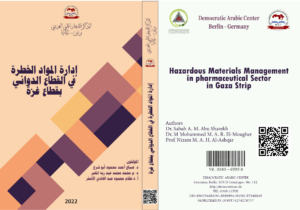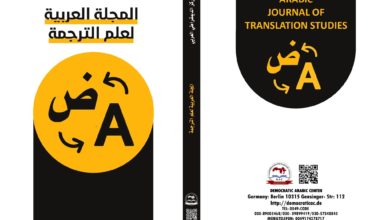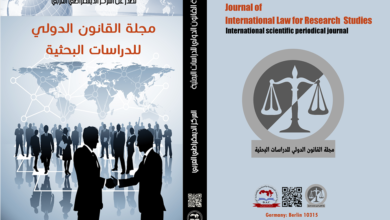إدارة المواد الخطرة في القطاع الدوائي بقطاع غزة
Hazardous Materials Management in pharmaceutical Sector in Gaza Strip

المؤلفون : –
- د. صباح أحمد محمود أبو شرخ
- د. م محمد محمد عبد ربه المغير
- أ. د نظام محمود عبد الهادي الأشقر
نسخة “pdf”-
إدارة المواد الخطرة في القطاع الدوائي بقطاع غزة
الطبعة الأولى “2022″ –من كتاب: – إدارة المواد الخطرة في القطاع الدوائي بقطاع غزة
جميع حقوق الطبع محفوظة #المركز_الديمقراطي_العربي ولا يسمح بإعادة إصدار هذا الكتاب أو اي جزء منه أو تخزينه في نطاق إستعادة المعلومات أو نقله بأي شكل من الأشكال، دون إذن مسبق خطي من الناشر .
تقديم:
تتنوع المخاطر والمهددات التى تواجه قطاع غزة والتي رسمت معالم التحديات للمكونات الادارية والهيئات والقطاعات الرسمية في قطاع غزة مما يتطلب التفكير لتحسين الحالة التنموية للمجتمع الفلسطيني، خاصة وأن قطاع غزة يعاني من حصار إسرائيلي خانق ويتحكم بالمنافذ والتي تؤثر بشكل مباشر على منظومة المراحل الإدارية للقطاع الدوائي والتي تشمل الاستيراد، والنقل، والتخزين، والتداول، والتخلص.
لقد أحدثت الأزمات التي تعصف بواقع قطاع غزة تغييراً جوهريًا في نمط المنظومة الإدارية لقطاع غزة وذلك عبر التخطيط المستمر للحد من الخسائر البشرية والمادية والبيئة ودراسة انعكاسات كل قطاع على الآخر وانعكاس قيود الاحتلال على القطاع الدوائي، مما ساهم في تحسين أساليب وإجراءات الجهوزية والاستعداد والتخطيط لتوزيع الاحتياجات من الأدوية والمستلزمات الطبية بشكل مستمر بهدف الحد أو التقليل من الآثار السلبية للأزمات، وهذا يمكن أن يساعد صناع القرار بالتحكم المخاطر المتوقعة قدر الإمكان.
يتكون القطاع الدوائي من القطاع الحكومي العام متمثل في الإدارة العامة للصيدلة ولجنة الصيدلة والدواء، وشركات الأدوية ونقابة الصيادلة ومستودعات تخزين الأدوية والمستلزمات الطبية والصيدليات العاملة في القطاع العام والخاص والمجتمعي والأهلي والمنظمات الدولية التى تساهم في تنظيم الأدلة المعيارية بالشراكة مع وزارة الصحة الفلسطينية، والعيادات الخاصة والأونروا التى لها باع طويل في تقديم خدمات الرعاية الأولية.
ساهم الحصار الاسرائيلي على قطاع غزة وسياسات الاحتلال الخانقة بالتأثير السلبي الواضح، وذلك بارتفاع مستويات العجز في المستهلكات الطبية والأدوية والاحتياجات العلاجية والتي شكلت تحديًا أمام صناع القرار في قيادة الإدارة العامة للصيدلة وشركاء القطاع الدوائي، فقد تغيرت كثيرا من الأدوات والآليات والوسائل على الصعيد البشري والاجتماعي والاقتصادي والتنموي المرتبط بالقطاع الدوائي بدرجة قاربت النقيض لما كانت عليه قبل الحصار، وخاصة البنية الاستثمارية في مجالات البحث العلمي بخصوص المخاطر المتوقع أن تتعرض لها المجتمع الفلسطيني وانتشار الأوبئة والجوائح والأمراض والاصابات الناتجة عن الاعتداءات العسكرية.
الهدف الرئيسي للكتاب الحالي يتمحور حول بيان واقع إدارة المواد الخطرة في قطاع غزة-حالة دراسية للقطاع الدوائي، وتحديد وتحليل منظومة المراحل الإدارية للقطاع الدوائي والتي تشمل الاستيراد، والنقل، والتخزين، والتداول، والتخلص. ودراسة العلاقة التفاعلية بين تلك البيانات وآراء الخبراء والمهنيين التي يتم طرحها حول مراحل إدارة القطاع الدوائي والصيدلاني والمستلزمات الطبية، والعلاقة بين أطراف الانتاج والوعي بأهمية التعامل وفق منظومة إدارية محددة مسبقًا بلوائح تقرها السلطات المختصة.
يُعد التخطيط لعمليات إدارة القطاع الدوائي من أولويات لجنة السياسات الوطنية نظرًا لارتباطها الوثيق بالسياسات الوطنية الخاصة بالصحة المجتمعية، وإدارة الأزمات الدوائية بفعالية وبمساهمة من كافة الأطراف ذات العلاقة بما فيها المجتمع المتضرر من الحصار الخانق على قطاع غزة، والرفع مستويات الجهوزية للاستعداد لكافة الآثار الناتجة عن الاعتداءات العسكرية المتكررة في قطاع غزة وتوفير الاحتياجات للمستشفيات الميدانية العاملة في القطاع، ويتم ذلك بشكل مستمر ودائم بمشاركة كافة الجهات المعنية بعمليات رسم الملامح المشتركة لإدارة القطاع الدوائي وذلك بما يتوافق مع حجم التهديدات والمخاطر المحتملة.
يساهم هذا الكتاب في وضع تصورات مستقبلية لصانعي القرار في الإدارة العامة للصيدلة، حول المنهجية التى تتبع في إدارة القطاع الصيدلاني وفق مراحل متعددة تبدأ بعمليات الاستيراد من المعابر سواء الأدوية المستوردة أو المتبرع بها، أو المواد الخام المستخدمة في عمليات التصنيع الدوائي، سواء من الناحية العملية في تطبيق المقترحات المقدمة في هذا الكتاب والتي يصلح تطبيقها في قطاع غزة او أي منطقة لها نفس الظروف المتشابهة، أو معالجة القضايا المعقدة المرتبطة بوقوع المخاطر المعقدة والتي تتطلب اتخاذ قرارات حادة في إدارة القطاع الدوائي، ليكون مرجع علمي هام لكافة الباحثين والمختصين في هذا المجال.
Authors
Dr. Sabah A. M. Abu Sharekh
Dr. M Mohammed M. A. R. El-Mougher
Prof. Nizam M. A. H. Al-Ashqar
Abstract
The risks and threats facing the Gaza Strip are diverse and have shaped the challenges for the administrative components, bodies and official sectors in the Gaza Strip. This requires thinking to improve the developmental situation of the Palestinian society, especially that the Gaza Strip suffers from a suffocating Israeli siege and controls the crossings, which directly affects the administrative stages of the pharmaceutical sector, including import, transport, storage, handling and disposal.
The crises in the Gaza Strip have fundamentally altered the pattern of the Gaza Strip’s administrative system, through continuous planning to reduce human, material and environmental losses and by studying the repercussions of each sector on the other and the reflection of the occupation’s restrictions on the pharmaceutical sector. This has contributed to improving the methods and procedures of preparedness and planning for the continuous distribution of the needed medicines and medical supplies with the aim of reducing or minimizing the negative effects of crises, which in turn can help decision-makers to control the expected risks as much as possible.
The pharmaceutical sector consists of the public government sector, which is represented by the General Directorate of Pharmacy, the Pharmacy and Drug Committee, pharmaceutical companies, the Pharmacists Syndicate, warehouses for the storage of medicines and medical supplies, pharmacies operating in the public, private, community and civil sectors, in addition to international organizations that are involved in developing guidelines in partnership with the Palestinian Ministry of Health, private clinics and UNRWA, which have a long history of providing primary care services.
The Israeli siege of the Gaza Strip and the occupation’s stifling policies have clear and negative impacts, through increasing the shortage levels of medical disposables, medicines and medical needs, which have posed a challenge to the decision-makers in the leadership of the General Directorate of Pharmacy and other partners in the pharmaceutical sector. Many of the tools, mechanisms and means at the human, social, economic and development levels linked to the pharmaceutical sector have changed to a degree that is close to the opposite of what they were before the siege, especially the investment structure in the fields of scientific research regarding the expected risks to the Palestinian society and the spread of epidemics, pandemics, diseases and injuries resulting from military attacks.
The main objective of the current book is to identify the reality of hazardous materials management in the Gaza Strip – a case study of the pharmaceutical sector, and to identify and analyse the system of administrative stages of the pharmaceutical sector, which includes import, transport, storage, handling, and disposal. And to study the interactive relationship between these data and the presented opinions of experts and professionals about the stages of management of the pharmaceutical sector and medical supplies, and about the relationship between different production parties, and the awareness of the importance of dealing according to a pre-defined administrative system with regulations approved by the competent authorities.
Planning for the management of the pharmaceutical sector is one of the priorities of the National Policy Committee, due to its tight connection with the national policies related to community health, and the effective management of pharmaceutical crises with the participation of all relevant parties, including the community affected by the suffocating siege on the Gaza Strip, and raising the levels of preparedness for all the consequences of repeated military aggressions on the Gaza Strip and providing the needs of field hospitals operating in the Strip, which is done on a continuous and permanent basis, with the participation of all stakeholders involved in the joint profiling of the management of the Pharmaceutical Sector, in line with the magnitude of potential threats and risks.
This book contributes to developing future visions for decision-makers in the General Directorate of Pharmacy, about the methodology to be followed in managing the pharmaceutical sector, in various stages, starting with import operations from crossings, whether imported or donated drugs, or raw materials used in pharmaceutical manufacturing operations, whether from a practical point in applying the proposals presented in this book, which can be applied in the Gaza Strip or any region with similar circumstances, or addressing the complex issues associated with the occurrence of complex risks that require making severe decisions in the management of the pharmaceutical sector, to be an important scientific reference for all researchers and specialists in this field.
- الناشر: المركز الديمقراطي العربي للدراسات الإستراتيجية والسياسية والاقتصادية





